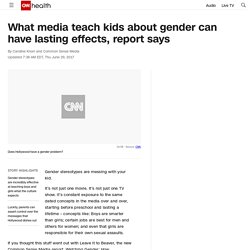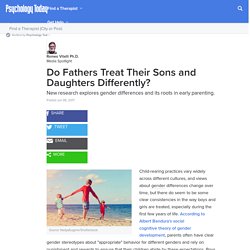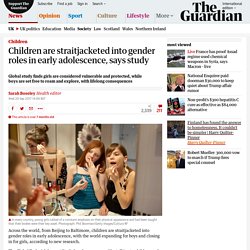

What media teach kids about gender can have lasting effects, report says. It's not just one movie.

It's not just one TV show. It's constant exposure to the same dated concepts in the media over and over, starting before preschool and lasting a lifetime -- concepts like: Boys are smarter than girls; certain jobs are best for men and others for women; and even that girls are responsible for their own sexual assaults.
According to the report, which analyzed more than 150 articles, interviews, books, and other social-scientific research, gender stereotypes in movies and on TV shows are more than persistent; they're incredibly effective at teaching kids what the culture expects of boys and girls. What makes these messages stick -- and harder for parents to counteract -- is that they're timed for the precise moment in kids' development when they're most receptive to their influence. Think of preschoolers who are just beginning to identify as boys or girls. These oversimplified characterizations play out in many ways over and over.
Age 2-6 At this age, kids: Age 7-10. Televised Gender Roles in Children?s Media: Covert Messages. OUR0042 Parenting and Early Years AA. Traditional gender roles have a big impact on today's society. The BLUE vs PINK gender stereotype. Boys vs Girls Toys. Gender specific aisles in stores promote gender labelling. Gender stereotyping in marketing & advertising. Paper advertising of toys as a representation of gender stereotypes. Books for young children can also present distorted representations of gender roles. Gender representation in video games often reflect traditional gender roles like the "damsel in distress" e.g. Mario, The Legend of Zelda.. Even movies such as those from Disney targeted at children can present harmful stereotypes and offensive representations of the idea of gender roles. The Internet may be the most influential form of media that teaches the world how to approach gender..and has the ability to amplify gender stereotypes in a negative way if the stereotypes/norms are perceived and internalised wrongly.
Girl toys vs boy toys: The experiment (Video) - This shows how parents, or adults in general, influence gender stereotypes on children based on their attitudes/behaviours of social origins, which also affects how they treat boys and girls differently. The home environment is an important factor that shows how influential parents are with regards to gender roles, and in terms of teaching and modelling, such as how both parents talk to and treat each other for instance. Studies have shown that parents treat sons and daughters differently from a young age. Source: NadyaEugene/Shutterstock Child-rearing practices vary widely across different cultures, and views about gender differences change over time, but there do seem to be some clear consistencies in the way boys and girls are treated, especially during the first few years of life.

According to Albert Bandura's social cognitive theory of gender development (link is external), parents often have clear gender stereotypes about "appropriate" behavior for different genders and rely on punishment and rewards to ensure that their children abide by these expectations. Boys are often discouraged from playing with dolls or acting "effeminately," while girls are often prevented from doing any physically risky activities. Some studies suggest that mothers talk more with their daughters and actively prevent them from any activity that might lead to their being injured.
For the purpose of the research, the fathers were asked to wear the EAR on a weekend day and a weekday. A study on how children are straitjacketed into gender roles in early adolescence. Across the world, from Beijing to Baltimore, children are straitjacketed into gender roles in early adolescence, with the world expanding for boys and closing in for girls, according to new research.

The Global Early Adolescent Study breaks new ground by talking to children and their parents in 15 countries around the world and finding a remarkably similar story. Girls approaching adolescence are considered vulnerable and protected, while boys are set free to roam and explore. That has consequences for their behaviour and expectations throughout their life. “We found children at a very early age – from the most conservative to the most liberal societies – quickly internalise this myth that girls are vulnerable and boys are strong and independent,” said Robert Blum, director of the Global Early Adolescent Study, based at Johns Hopkins University.
Children on Gender Roles (Video) - Gender role stereotypes are still very much evident in today's context, as seen from how children view what boys/girls should dress, look and the kind of toys they play with. Kids' assumptions are turned around at career day in school (Video) - Children are easily influenced by the media, role models and the environment, where preconceived ideas and stereotypes affect how children see diff jobs as "appropriate" for the genders. Nonbinary Gender Neutral Parenting (Video) - Gender neutral parenting seems to be trending these days, in an effort to prevent gender stereotyping and to not force gender norms on children. More movies these days are promoting a wider range of female and male characters that defy gender stereotypes, exposing children to more positive gender portrayals. Disney movies has also seen an evolution of redefined gender roles in recent years, especially with female Disney characters.
Society has seen a great shift in traditional gender roles, and there is less conformity to gender specific roles and gender identity, in favour of a more individual approach towards one's identity.